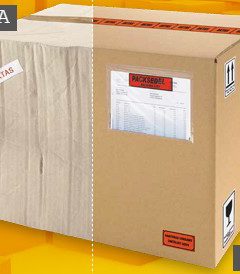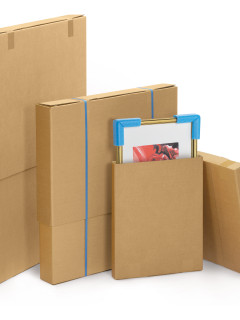As Europe’s No. 1 packaging company, we at RAJA often get questions about packing tables – how to create the optimal workstation and what are the benefits? Here’s a guide with lots of questions and answers, so you can get the right guidance when choosing packing tables for your business.
Why use packing tables?
A packing station optimised for your products and employees is a key factor in business success. As well as saving you time and money when the packing process is streamlined, you’re guaranteed that ergonomics are put first.
How do you choose the right packing station?
Consider the packing process for your particular products: what materials and tools do you need to have readily available to ensure a fast and ergonomic workflow? First choose the size of the workbench (1.6 x 0.8 m is recommended as standard), then decide whether you need static or dynamic height. Now you have your base and can build on it with the desired accessories.
RAJA’s range of packing tables and accessories
RAJA has a strong range of packing tables and accessories. RAJA’s own packing table is the most economical option and it has everything you need: durable table, shelves for boxes and tools, suspension for rolls of filler, and a cutting unit with ergonomic handle. The packing station is easy to assemble, taking an estimated 15 minutes for two people to put together.
The SYSTEM FLEX series from Hudig Rocholz is by far the best option for a customizable and flexible station based on your needs. You can easily adjust the height of shelves, legs and accessories. The perforated design of the shelves makes it easy to hook on extra accessories such as shelves, dispensers, etc. (without any tools), and to move them if necessary. The complete packing table includes table, columns, metal shelves and slats. Alternatively, you can choose an electronic height-adjustable packing table, which in addition to the table itself also includes three columns and two perforated back walls. Then add accessories as required.
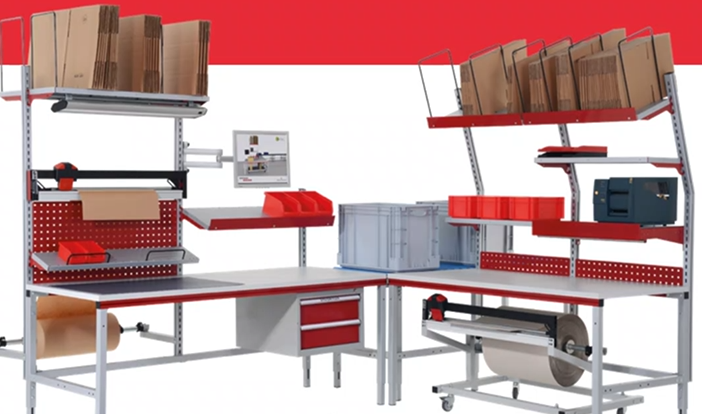
Need help choosing a packing station? Don’t hesitate to contact us at RAJA. Our packaging specialists are available by phone 010-33 08 200 or email info@rajapack.se, weekdays 8:00-17:00.
What should a packing table be equipped with?
Equip your packing table with tools and packaging adapted to your products. What you use most often should be easily accessible. The table below gives an overview of what this usually looks like for RAJA’s customers:
| A MUST |
USED OFTEN |
USED IN THE COUNTRY |
| – Boxes, e-commerce bags and/or envelopes – Packing tape and tape holders – Labels and printers – Shock absorption for filling and protection – Storage drawers for better organisation |
– Protective materials: kraft paper, bubble wrap or foam wrap. – Scissors or knife – Wastepaper basket – Barcode scanner – Writing materials |
– Packaging for special formats: e.g. extra flat or long boxes – Stapler for cardboard – Stretch film – Packing tape – Packing scale |
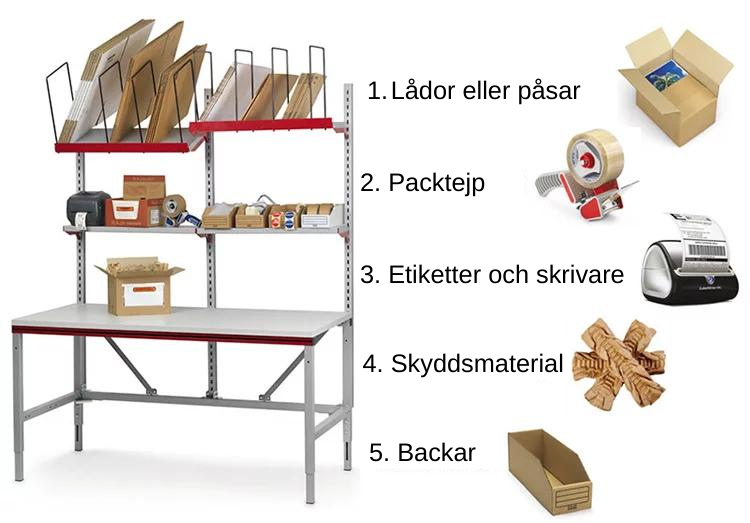
Bonus tip: sometimes it can be difficult to visualize what a particular tool or packing table accessory actually looks like. Hudig Rocholz has developed a virtual showroom where you can explore their packing tables and modules in 360°. You can also build your own packing table online in their packaging table configurator (select “System flex” as the base). Of course, if you need help customizing your workstation, you can turn to us at RAJA.
How to install the packing table?
Once you have all the packaging, tools and accessories you need, it’s time to plan what your packing table will look like. This means making sure each tool has its optimal place. To make packing as quick and efficient as possible, the most commonly used materials need to be close at hand. To visualise this, we divide the workstation into three zones:
- Zone 1 – Centre: the centre of the table should provide sufficient free space for the packing process. A free and spacious working area is a must. Within horizontal reach are items that will be used regularly. These include tape, a label printer and smaller trays where pens, stickers, scissors, etc. can be stored. A dispenser for protective materials (roll of kraft paper or bubble wrap) is certainly useful there as well.
- Zone 2 – Top: If you look up, you’ll find all the “outer packaging” there. Cartons, bags, envelopes, etc. Shelves with dividers make it easy to separate the different formats and get to them quickly.
- Zone 3 – Below: it would be a shame not to use the space under the packing table.
Here you still have enough space for a large dispenser (for bubble wrap, for example). You can also place a few larger boxes there. - Extra: do you handle a lot of orders and parcels every day? Use a separate machine next to your packing table for cushioning material. You can choose paper or air cushions. Don’t forget to place a wastepaper basket near the packing table.
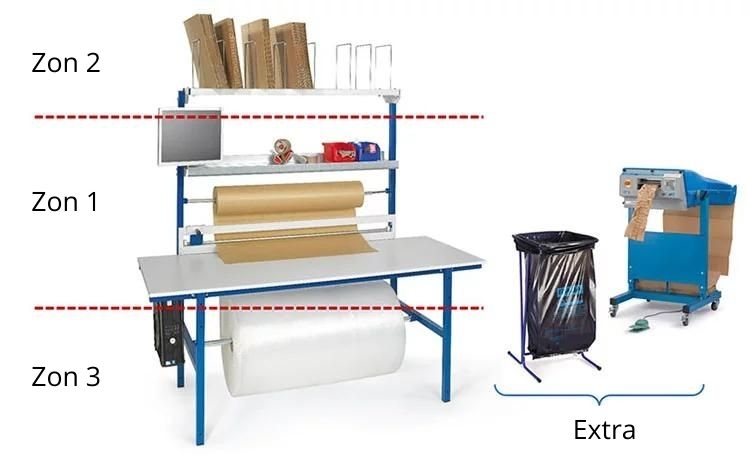
Why is ergonomics important?
If you invest in ergonomics, you will see many benefits: happier employees, a more sustainable way of working, fewer sick days, greater certainty in your planning, and of course the most important: better health for your employees. In addition to the requirements placed on employers in Sweden, considering ergonomics in the workplace should be seen as natural if you care about the well-being of your employees.
A poorly designed workplace can lead to musculoskeletal disorders (MSDs). Think hunched shoulders, back or leg pain, etc. That’s why it’s important to set up the packing table so that it’s comfortable to use correctly.
What does an ergonomic packing station look like?
The workstation should be designed to support proper ergonomics during the packing process. Angles need to be taken into account, making it as easy as possible to have good posture without even thinking about it, and to avoid unnecessary stretching. Here are four things to consider when adapting a packing station for ergonomics:
1. Correct working height
The correct working height allows the worker to maintain good posture while performing the work. The correct working height depends on the height of the worker and the nature of the work, see table below. Packing is generally considered as “light work”, which means a height of about 85 to 95 cm for the bench top. As a reference, use the height between hips and elbows. If you use a height-adjustable table, it is easy to adjust the height according to the different tasks and employees.
| Type of work: | Precision work | Light work | Heavy work |
| Work table height: | 95 – 110 cm | 85 – 95 cm | 70 – 90 cm |
| Height of the work surface: | At elbow height | Between hip and elbow | At hip height |
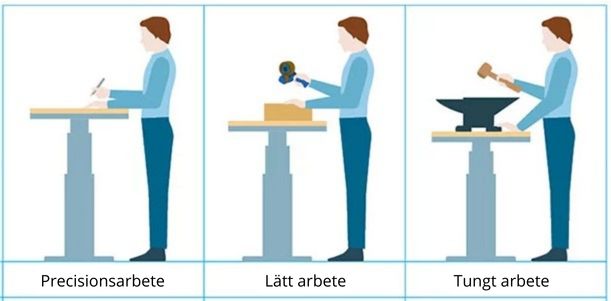
2. Horizontal grip distance
Ensuring that the most commonly used materials and tools are close at hand avoids unnecessary bending and stretching of the worker’s back, neck and arms. In the figure below, the “comfortable grip distance” corresponds to the location of the materials you use most often. This is approximately the distance between the wrist and the elbow. Then there is the “maximum grip distance”. This corresponds to the distance between the wrist and the shoulder (when you extend your arm). Here you can store materials that are not used very often.
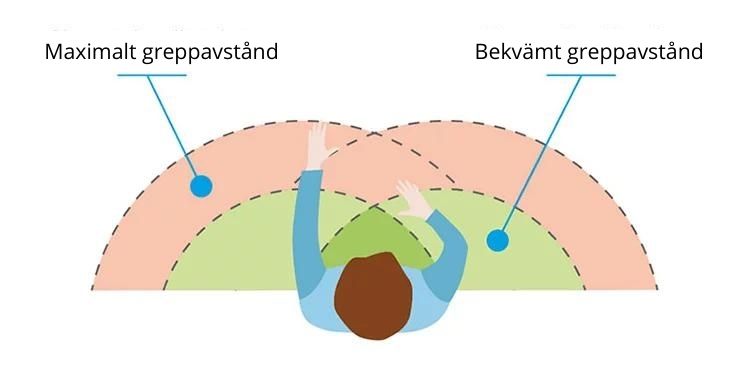
Bonus tip: the columns of the SYSTEM FLEX series upper parts can be mounted inclined at 20°, making it easier to grip the material stored there without having to reach for it.
3. Angle for visual information
A sheet of packing instructions or an order information screen can be a handy asset for those who want to pack their orders smoothly. Where is the best place to display this information? It depends on the field of view and its horizon line. It is best to view important or frequently used information at a 40° angle. At a magnified angle of 25° above and below, you can place additional information. This way the packer does not have to bend his neck too far and can reduce the risk of MSD.
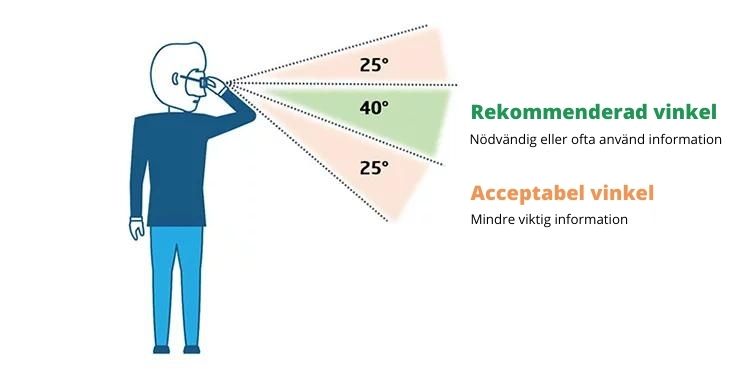
4. Vary the working position and encourage movement
There is no single optimal working position, what matters is variation. Alternate between standing, walking and sitting and take breaks several times during the day. Getting into the habit of varying your working position throughout the day will reduce the risk of MSDs. Also make sure that the chairs or stools used in offices and warehouses are ergonomic.
Need help choosing the right packing table?
RAJA are specialists in packaging and logistics. Please contact us for tips and advice on packing desks and ergonomics. The number is 010 – 33 08 200 and we are open weekdays 08:00-17:00.
Stay in touch with us
- Subscribe to our newsletter for the latest packaging news and access to exclusive promotions
- Follow RAJA Sweden on Linkedin, Facebook and Instagram
- Check out our latest product catalogue – order a free copy or read the interactive catalogue online













